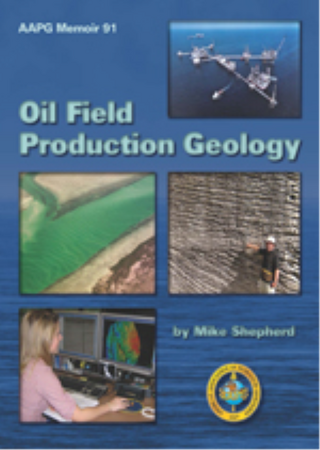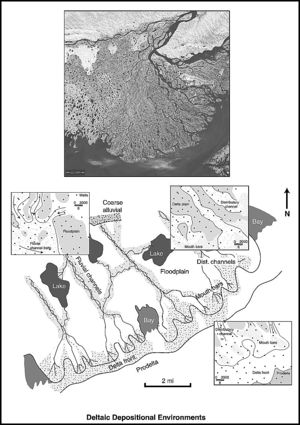Difference between revisions of "Deltaic reservoirs"
(Created page with "'''THIS PAGE IS UNDER CONSTRUCTION {{publication | image = Oil-field-production-geology.png | series = Memoirs | title = Oil Field Production Geology | part = Th...") |
|||
| Line 30: | Line 30: | ||
| Growth faults common || - || Numerous sealing fault compartments | | Growth faults common || - || Numerous sealing fault compartments | ||
|- | |- | ||
| − | | | + | | Shingled geometry || - || Results in bypassed oil in individual shingles |
| − | + | |- | |
| + | | Increasing marine reworking of delta front || Creates increasing lateral connectivity in the delta-front sediments || - | ||
| + | |- | ||
| + | | Wave-dominated delta || More continuous, may have an aquifer || - | ||
| + | |- | ||
| + | | Fluvial-dominated delta || - || Can show low recoveries caused by labyrinthine geometry | ||
| + | |- | ||
| + | | Tidal-dominated delta || - || Low recoveries caused by complex geometry and numerous mud and silt baffles | ||
| + | |- | ||
| + | | Distributary channels form narrow sand bodies || - || May be missed by wells in fields with a large well spacing; difficult to locate injection wells | ||
| + | |- | ||
| + | | Distributary channel sands commonly the highest permeability facies association in deltas || Can be the most productive intervals in a delta || - | ||
| + | |- | ||
| + | | Stacked distributary channels || Larger sand bodies with good vertical connectivity and sweep || - | ||
| + | |- | ||
| + | | Mouth bars contain extensive mudstone laminae || - || Mouth bars may have poor vertical connectivity and sweep | ||
| + | |- | ||
| + | | Stacked mouth bars || Larger sand bodies with good vertical connectivity and sweep || - | ||
| + | |- | ||
| + | | Mouth bars separated vertically by shales || Individual mouth bars can be targeted by horizontal wells; shale prevents water influx from swept units above and below || Poor to no vertical connectivity between mouth bars | ||
| + | |- | ||
| + | | Coarser grained distributary channels cutting finer-grained delta-front sandstones || - || Can result in preferential water ingress into the delta-front area, bypassing oil in the delta-front sediments | ||
| + | |- | ||
| + | | Peripheral strand-plain complexes with high frequency marine shales || - || Poor vertical sweep with potential for bypassed oil | ||
|} | |} | ||
| + | ==Deltas are often gas reservoirs== | ||
| + | Many deltaic reservoirs, particularly long-lived Tertiary to present-day delta areas, contain more gas than oil. This is because they can be particularly rich in coals and woody kerogen, which form gas-prone humic source material. Gas fields are found in the Mackenzie, Nile, and Irrawady deltas, for instance. Deltas can contain oil or mixed oil and gas where sandstones interfinger with a marine source rock.<ref name=Gallowayandhobday_1996>Galloway, W. E., and D. K. Hobday, 1996, Terrigenous clastic depositional systems: Applications to petroleum, coal, and uranium exploration: New York, Springer-Verlag, 489 p.</ref> | ||
Revision as of 21:39, 12 August 2015
THIS PAGE IS UNDER CONSTRUCTION
| Oil Field Production Geology | |

| |
| Series | Memoirs |
|---|---|
| Part | The Production Geologist and the Reservoir |
| Chapter | Deltaic reservoirs |
| Author | Mike Shepherd |
| Link | Web page |
| PDF file (requires access) | |
| Store | AAPG Store |

Deltas are major sites of sand and mud deposition. They contain significant volumes of hydrocarbons worldwide (Figure 1). Major petroleum provinces include the Niger Delta in west Africa, the Mahakam Delta in Borneo, the Caspian Sea, and the Maracaibo Basin in Venezuela.
Deltaic sediments often form complex reservoirs
Delta systems make heterogeneous reservoirs, typically with a jigsaw-puzzle to labyrinthine sediment geometry (Table 1). There may also be considerable structural complexity. Many rivers, particularly the larger ones, dump very large quantities of sediment into deltas on top of an unstable substrate containing mobile salt and/or shale. Salt deformation features and growth faulting are common in deltaic sediments, and these can result in numerous segmented reservoirs, such as in the Tertiary Niger Delta in west Africa.[2][3]
| Characteristic | Favorable for reservoir development | Unfavorable for reservoir development |
|---|---|---|
| Growth faults common | - | Numerous sealing fault compartments |
| Shingled geometry | - | Results in bypassed oil in individual shingles |
| Increasing marine reworking of delta front | Creates increasing lateral connectivity in the delta-front sediments | - |
| Wave-dominated delta | More continuous, may have an aquifer | - |
| Fluvial-dominated delta | - | Can show low recoveries caused by labyrinthine geometry |
| Tidal-dominated delta | - | Low recoveries caused by complex geometry and numerous mud and silt baffles |
| Distributary channels form narrow sand bodies | - | May be missed by wells in fields with a large well spacing; difficult to locate injection wells |
| Distributary channel sands commonly the highest permeability facies association in deltas | Can be the most productive intervals in a delta | - |
| Stacked distributary channels | Larger sand bodies with good vertical connectivity and sweep | - |
| Mouth bars contain extensive mudstone laminae | - | Mouth bars may have poor vertical connectivity and sweep |
| Stacked mouth bars | Larger sand bodies with good vertical connectivity and sweep | - |
| Mouth bars separated vertically by shales | Individual mouth bars can be targeted by horizontal wells; shale prevents water influx from swept units above and below | Poor to no vertical connectivity between mouth bars |
| Coarser grained distributary channels cutting finer-grained delta-front sandstones | - | Can result in preferential water ingress into the delta-front area, bypassing oil in the delta-front sediments |
| Peripheral strand-plain complexes with high frequency marine shales | - | Poor vertical sweep with potential for bypassed oil |
Deltas are often gas reservoirs
Many deltaic reservoirs, particularly long-lived Tertiary to present-day delta areas, contain more gas than oil. This is because they can be particularly rich in coals and woody kerogen, which form gas-prone humic source material. Gas fields are found in the Mackenzie, Nile, and Irrawady deltas, for instance. Deltas can contain oil or mixed oil and gas where sandstones interfinger with a marine source rock.[4]
See also
- Eolian reservoirs
- Meandering fluvial reservoirs
- Braided fluvial reservoirs
- Siliciclastic shorelines and barrier island reservoirs
- Deep-water marine reservoirs
- Carbonate reservoirs
References
- ↑ Tye, R. S., J. P. Bhattacharya, J. A. Lorsong, S. T. Sindelar, D. G. Knock, D. D. Puls, and R. A. Levinson, 1999, Geology and stratigraphy of fluvio-deltaic deposits in the Ivishak Formation: Applications for development of Prudhoe Bay field, Alaska: AAPG Bulletin, v. 83, no. 10, p. 1588–1623.
- ↑ Evamy, B. D., J. Haremboure, P. Kamerling, W. A. Knaap, F. A. Molloy, and P. H. Rowlands, 1978, Hydrocarbon habitat of Tertiary Niger Delta: AAPG Bulletin, v. 62, no. 1, p. 1–39.
- ↑ Tuttle, M. L. W., R. R. Charpentier, and M. E. Brownfield, 1999, The Niger Delta petroleum system: Niger Delta Province, Nigeria, Cameroon, and Equatorial Guinea, Africa: U.S. Geological Survey Open File Report 99-501, 210 p.
- ↑ Galloway, W. E., and D. K. Hobday, 1996, Terrigenous clastic depositional systems: Applications to petroleum, coal, and uranium exploration: New York, Springer-Verlag, 489 p.